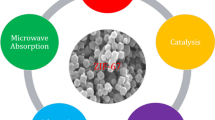Abstract
A mixed-valence Pd0/IIO nanocomposite microsphere (Pd0/IIONPs@CMC–Al) was prepared by Al3+ ion crosslinked carboxymethylcellulose (CMC) procedure using PdO nanoparticles (NPs) and sodium carboxymethylcellulose in an Al(NO3)3 solution. As evidenced by X-ray photoelectron spectroscopy (XPS), the Pd0 was generated in situ on the surface of PdO NPs through the reduction of CMC in the formation of composite microspheres. The identity of the as-prepared Pd0/IIONPs@CMC–Al microsphere was fully verified using various techniques such as Fourier transform infrared spectroscopy (FTIR), X-ray diffraction (XRD), scanning electron microscopy (SEM), transmission electron microscopy (TEM), X-ray photoelectron spectroscopy (XPS), energy dispersive X-ray analysis (EDX), elemental mappings, and thermogravimetric analysis (TGA). The composite microsphere was found to be effective in the aminocarbonylations of various iodobenzenes with different benzyl amines, resulting in moderate to good yields of the desirable products using phenyl formate as a simple and efficient CO surrogate. The microsphere can be easily recovered through simple filtration and can be recycled for up to five consecutive runs without losing its activity. The advantages include the ease of handling the catalyst, no additional reducing agent required, simple workup procedure, tolerance for a wide range of functional groups, and effective catalyst recyclability, all of which enhances its practical applicability.
Graphical Abstract












Similar content being viewed by others
Availability of data and materials
All data generated or analyzed during this study are included in this published article and its supplementary information files.
References
Allen CL, Williams JM (2011) Chem Soc Rev 40:3405–3415
Schoenberg A, Heck R (1974) J Org Chem 39:3327–3331
Abdulla Afsina CM, Philip RM, Saranya PV et al (2022) Curr Org Synth 20:308–331
Picard B, Fukuyama T, Ryu I (2023) J Org Chem 88:5220–5225
Wang P, Yang J, Sun K et al (2022) Org Chem Front 9:2491–2497
Richardson J, Rilvin-Derrick E, Oram N (2020) Synlett 31:369–372
Collin HP, Reis WJ, Nielsen DU (2019) Org Lett 21:5775–5778
Messa F, Perrone S, Capua M et al (2018) Chem Commun 54:8100–8103
Wang DL, Liu H, Yang D et al (2017) ChemCatChem 9:4206–4211
Zhang C, Liu J, Xia C (2014) Org Biomol Chem 12:9702–9706
Xu T, Alper H (2013) Tetrahedron Lett 54:5496–5499
Sengupta M, Das S, Bhattacharya S et al (2022) Mol Catal 522:112212
Shaifali S, Bains R et al (2020) Org Biomol Chem 18:7193–7200
Mart M, Tylus W, Trzeciak AM (2019) Mol Catal 462:28–36
Lei Y, Wan Y, Li G et al (2017) Mater Chem Front 1:1541–1549
Hu Q, Wang L, Wang C et al (2017) RSC Adv 7:37200–37207
Mane RS, Sasaki T, Bhanage BM (2015) RSC Adv 5:94776–94785
Nejad MJ, Shariatipour M, Heydari A (2023) Catal Lett 153:1957–1973
Dang TT, Zhu Y, Ngiam JSY et al (2013) ACS Catal 3:1406–1410
Khedkar MV, Sasaki T, Bhanage BM (2013) ACS Catal 3:287–293
Qureshi ZS, Revankar SA, Khedkar MV et al (2012) Catal Today 198:148–153
Tinnis F, Verho O, Gustafson KPJ et al (2014) Chem Eur J 20:5885–5889
Biying AO, Yuanting KT, Hosmane NS et al (2013) J Organomet Chem 747:184–188
Zhang Y, Sun H, Zhang W, Gao Z et al (2015) Appl Catal A-Gen 496:9–16
Urbána B, Pappa M, Srankó D et al (2015) J Mol Catal A-Chem 397:150–157
Seok S, Hussain MA, Park KJ et al (2016) Ultrason Sonochem 8:178–184
Lakshminarayana B, Mahendar L, Ghosal P et al (2017) ChemistrySelect 2:2703–2710
Lu X, Yu Q, Tao X et al (2021) Colloid Surfaces A 610:125914
Okumura K, Mushiake T, Matsui Y et al (2015) ChemPhysChem 16:1719–1726
Ohtaka A, Teratani T, Fujii R et al (2011) J Org Chem 76:4052–4060
Teratani T, Ohtaka A, Kawashima T et al (2010) Synlett 15:2271–2274
Sadhasivam V, Balasaravanan R, Siva A (2019) Appl Organometal Chem 33:e4994
Rahman MS, Hasan MS, Nitai AS et al (2021) Polymers 13:1345
Xiao J, Lu Z, Li Y (2015) Ind Eng Chem Res 54:790–797
Xiao J, Lu Z, Li Z et al (2015) Appl Organometal Chem 29:646–652
Ueda T, Konishi H, Manabe K (2012) Org Lett 14:3100–3103
Fujihara T, Hosoki T, Katafuchi Y et al (2012) Chem Commun 48:8012–8014
Arora K, Srivastava S, Solanki PR et al (2019) IEEE Sens J 19:8262–8271
Tan L, Li H, Liu M (2018) RSC Adv 8:12870–12878
Zhang Z, Song P, Zhou J et al (2016) Ind Eng Chem Res 55:12301–12308
Wang TJ, Li FM, Huang H et al (2020) Adv Funct Mater 30:2000534
Kozlica DK, Kokalj A, Milošev I (2021) Corros Sci 182:109082
Zhang L, Ding LX, Luo Y et al (2018) Chem Eng J 347:193–201
Barkhordari S, Yadollahi M (2016) App Clay Sci 121–122:77–85
Calegari F, da Silva BC, Tedim J et al (2020) Prog Org Coat 138:105329
Konishi H, Matsubara M, Mori K et al (2017) Adv Synth Catal 359:3592–3601
Ozawa F, Kawasaki N, Okamoto H et al (1987) Organometallics 6:1640–1651
Acknowledgements
This work was financially supported by the Natural Science Foundation of Guangdong Province (No. 2020A1515010399).
Author information
Authors and Affiliations
Contributions
YZ and LX Investigation, Methodology, Validation, Writing-original draft. YH and YQ Investigation, Methodology. YL Conceptualization, Resources, Writing-review & editing, Supervision, Project administration, Funding acquisition.
Corresponding author
Ethics declarations
Conflict of interest
No conflict of interest.
Ethics approval
Not applicable.
Additional information
Publisher's Note
Springer Nature remains neutral with regard to jurisdictional claims in published maps and institutional affiliations.
Supplementary Information
Below is the link to the electronic supplementary material.
Rights and permissions
Springer Nature or its licensor (e.g. a society or other partner) holds exclusive rights to this article under a publishing agreement with the author(s) or other rightsholder(s); author self-archiving of the accepted manuscript version of this article is solely governed by the terms of such publishing agreement and applicable law.
About this article
Cite this article
Zhou, Y., Xiao, L., Huang, Y. et al. Facile Shaping Mixed-valence Pd0/IIO Nanoparticles in Al3+ Crosslinked Carboxymethylcellulose Microspheres for Catalytic Aminocarbonylations. Catal Lett (2024). https://doi.org/10.1007/s10562-024-04625-x
Received:
Accepted:
Published:
DOI: https://doi.org/10.1007/s10562-024-04625-x




